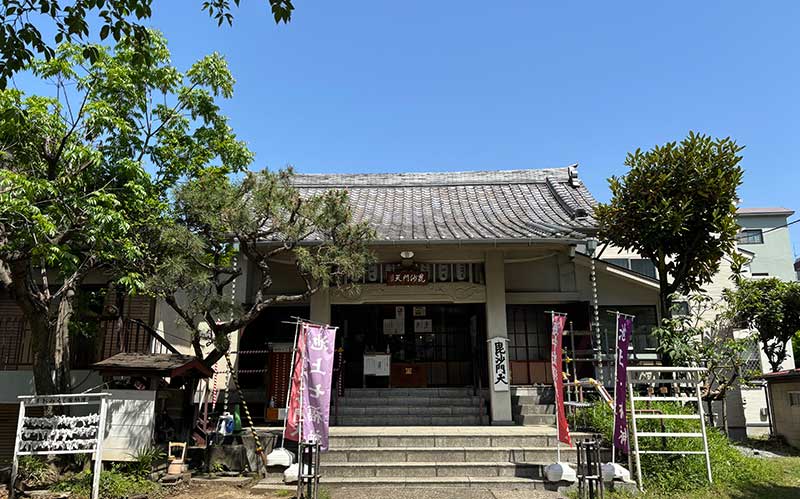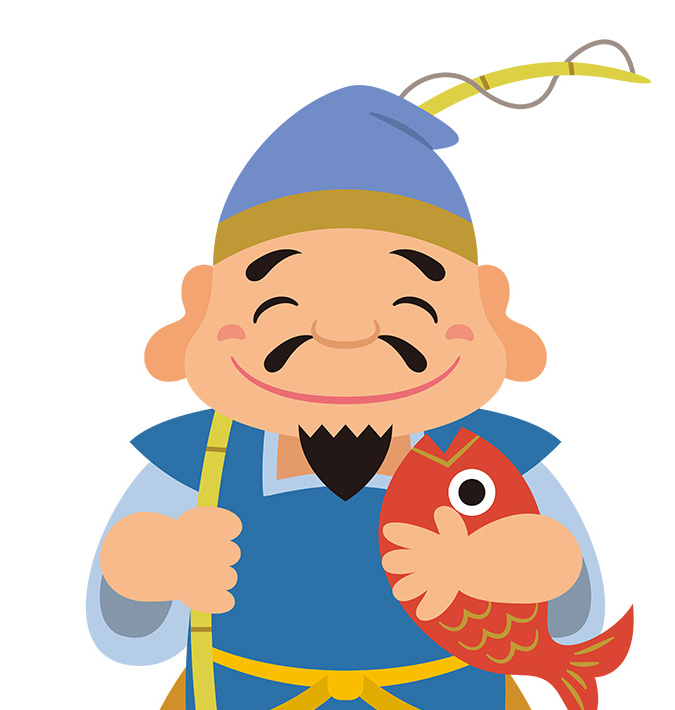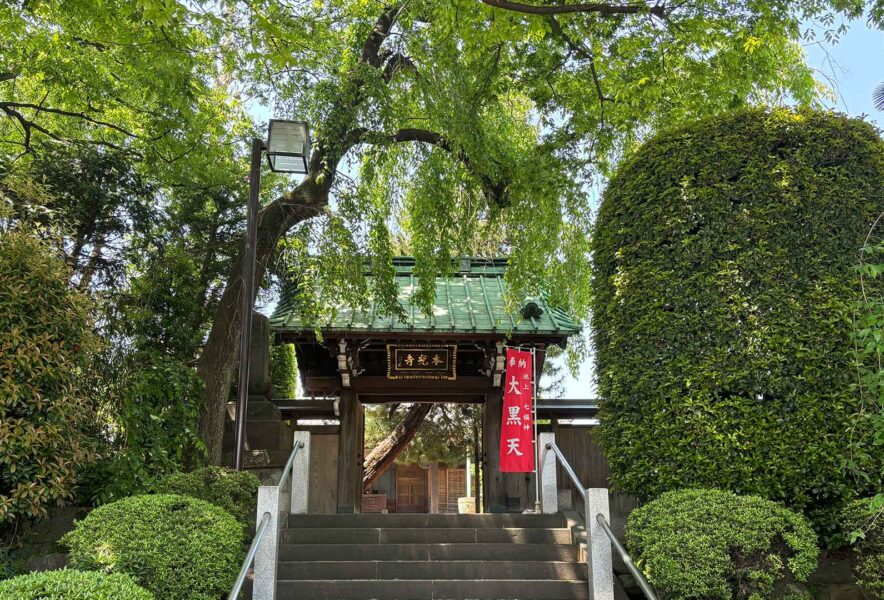Tokyo Stroll: Ikegami Seven Lucky Gods Tour
The Ikegami Shichifukujin was created in 1981 to commemorate the 700th anniversary of Nichiren Shonin. The statues of the Seven Gods of Good Fortune enshrined at each temple were created by Takemine Hiraoka, a master Itto-bori carver, and the opening ceremony was held at Shoei-in Temple in 1981. There are three Shichifukujin (Inari) in Ota Ward. While visiting the shrine, enjoy a walk in Ikegami, which still retains the atmosphere of a temple town.
- What is Shichifukujin?
- What is Ikegami Shichifukujin?
- Today’s route: Ikegami Shichifukujin pilgrimage stroll
- Start of Ikegami Shichifukujin pilgrimage stroll
- Ikegami Kuzumochi Showdown
- Ikegami Shichifukujin Tour Summary and Strolling Tips
- Ikegami Shichifukujin pilgrimage stroll Recommended articles in the vicinity
What is Shichifukujin?
Shichifukujin is the collective name for seven deities: Ebisu, Daikokuten, Bishamonten, Benzaiten, Jurojin, Fukurokuju, and Hotei. The belief in the Seven Gods of Good Fortune originated in the words of the Ninno-Hannya Sutra, the second volume of which was written in the middle of the Muromachi period (1336-1573), “Seven pains will be quickly destroyed and seven blessings will be quickly born,” and spread widely among the common people as “the belief that brings happiness. It is said that worshippers of the Seven Deities of Good Fortune will be rid of seven misfortunes and receive seven blessings.
Benefits of the Seven Gods of Good Fortune

Illustration from left
【Bishamonten 毘沙門天】Great wish fulfillment, harmony and good fortune
【Fukurokuju 福禄寿】Invitation to good fortune and popularity
【Hotei 布袋尊】Laughter and happiness, marital bliss, childbirth.
【Ebisu 恵比寿】 Thriving business
【Daikokuten 大黒天】Fortune, prosperity of descendants
【Jurojin 寿老人】 Longevity, prolonged life, wealth and longevity
【Benzaiten 弁財天】Wisdom, treasure, charm, and marriage
What is Ikegami Shichifukujin?
The Ikegami Shichifukujin was founded in 1981 by volunteers in Ikegami to commemorate the 700th anniversary of the passing of Nichiren Shonin.
The statues of the Seven Gods of Good Fortune enshrined at each temple were created by Takemine Hiraoka, a master carver of the Shikoku Kotohira Itto-bori carving technique, and the opening ceremony was held at Shoei-in Temple.
Today’s route: Ikegami Shichifukujin pilgrimage stroll
A.(Start) Ikegami station
B.Souzenji Temple (Hotei)
C.Mimyoan (Bishamonten)
D.Hosyuzan Honkoji Temple (Daikokuten)
E.Gonjyouin Temple (Benzaiten)
F.Honjo-in Temple (Fukurokuju)
G.Shoei-in Myoken-do (Jurojin)
H.Yogenji Temple (Ebisu)
I.(Goal) Ikegami Station
Start of Ikegami Shichifukujin pilgrimage stroll
A.Start Ikegami station
Ikegami Station is approximately 40 minutes from Tokyo Station via Kamata Station and approximately 45 minutes from Shinjuku Station via Gotanda Station. Take the 3-car Tokyu Ikegami Line between Kamata and Gotanda Stations. Ikegami Station is 3 minutes from Kamata Station and 19 minutes from Gotanda Station.
Get off at Ikegami Station on the Ikegami Line, which runs through one of Tokyo’s most laid-back towns, and walk straight through the bustling downtown-style shopping district, turn left at the railroad crossing, and walk straight down the quiet street.

B.Souzenji Temple(Hotei 布袋尊)

【Hotei 布袋尊】
Laughter and happiness, marital bliss, childbirth.
For those who collect stamps for the Seven Lucky Gods Tour, colored paper is sold at each temple. You can purchase them at the starting temple and visit the temple. Today we will start our tour from Sozen-ji Temple. Hotei (Hotei means “the seven gods” in Japanese) is believed to be an incarnation of Maitreya Bodhisattva, who bestows good fortune, happiness, and endurance.
The Soto sect was founded about 800 years ago during the Kamakura period (1185-1333) by Zen Master Dogen, who introduced the Buddhist teachings from China.
There were no Soto Zen temples in the Ikegami area. In 1939, an application to the Tokyo Metropolitan Government for permission to build a new Soto Zen temple was denied, so the temple was renamed Seikoin Temple, originally located in Ushigome, and renamed Sozenji Temple, and a hall was built on this site. The present building was rebuilt after the war.


Address: 7-22-10 Ikegami, Ota-ku, Tokyo
TEL: 03-3751-0678
Official Site:Click here

We walk along a spacious but quiet street with few cars passing by.
C.Mimyoan (Bishamonten 毘沙門天)

Bishamonten
Great wish fulfillment, harmony and good fortune
Mimyoan was built as one of the halls of the Honmonji pagoda Kakugenji. It belongs to the Nichiren sect of Buddhism. The temple’s principal deity, Bishamonten, is a statue said to have been found off the coast of Shinagawa and has since been worshipped as Bishamonten, one of the Ikegami Seven Deities of Good Luck.The date of Mimyoan’s construction is unknown, but it seems to have been built as part of Kakugenji, the pagoda of Ikegami Honmonji in Nichiren Shu. Bishamonten, one of the Four Heavenly Kings, also known as Tamonten, is the only one of the Seven Gods of Good Fortune to take the form of a warrior. Believers venerate Bishamonten as the god of harmony and good fortune.


Location: 3-38-23 Ikegami, Ota-ku, Tokyo
TEL:03-6303-5177
Official website:Click here
From here it is a short walk.
Cross the Second Keihin and head straight down a quiet back road towards Kugahara.
D.Hosyuzan Honkoji Temple (Daikokuten 大黒天)

Daikokuten
Fortune, prosperity of descendants
The temple was founded in 1597 by Nichinoh Shonin, a disciple of Nissei, the 12th head of Honmonji. To the west of the main hall is Shichimen-do (Hall of Seven Faces), where a statue of the Seven-faced Tennyo (Heavenly Maiden) was donated by the Kishu Tokugawa family in 1699 (Genroku 12).
Since the Genroku era (1688-1704), Shichimen Tennyo has attracted attention as an object of worship to protect the prosperity of the Latter Day of the Law, and this hall is also known as ‘Kugahara no Shichimen Tennyo’ and is revered by many believers.




Location: 2-19-17 Kugahara, Ota-ku, Tokyo
TEL:03-3751-4555

From here, return towards Ikegami again.
Cross the Second Keihin and walk towards Honmonji.
E.Gonjyouin Temple (Benzaiten 弁財天)

Benzaiten
Wisdom, treasure, charm, and marriage
It was founded in 1289 (Sho’o 2) by Shonin Nisson of Genjoin, a direct disciple of Shonin Nichiro, the second head of Ikegami Honmonji. It is said that in 1536, the temple was merged with Seijobo, which was located next to Nishino-in Temple in Nishitani, and a hall was built in its present location. In the precincts of Seishobo, there used to be a Benten (guardian deity), which is enshrined as one of the seven gods of good fortune of Ikegami in the stone Benten-gu Shrine.
In 1920, the “Kosodate Kishimojin” was invited to the temple, and in 1931, the Kishimojin Hall was built as a separate temple in front of the Honmonji So-mon gate.


Location: 2-10-12 Ikegami, Ota-ku, Tokyo
TEL:03-3751-6767
Official Site:Click here
Turn in front of the gate of Ikegamihonmonji Temple to the approach.


F.Honjo-in Temple (Fukurokuju 福禄寿)

Fukurokuju
Invitation to good fortune and popularity
Fukurokuju is revered as an elderly god who brings good fortune, wealth, and longevity.
Honjoin Temple was founded in the Kamakura period (1185-1333) as the hermitage of Nichiren Shoshu’s direct disciple, Hinata Shonin. During the Keicho era (1596-1615), it was developed as a retreat for Nisson Shonin, the 13th head of Ikegami Honmonji, but was destroyed by fire during the Hoei era (1704-1711). It was moved to its current location during the Kyoho era (1716-1736) and rebuilt to become Honjoin.



Location: 1-35-3 Ikegami, Ota-ku, Tokyo
TEL:03-3751-0111
Follow the Nomi River toward Ikegami Dori.

Steep stairs lead up from the side of Myokendo, but if you are worried about going up and down the stairs, you can also go from the elevator of the nearby Ikegami Kaikan.
G.Shoei-in Myoken-do (Jurojin 寿老人)

Jurojin
Longevity, prolonged life, wealth and longevity
After climbing the steep, long stone steps of Myokenzaka, the hall, Myokendo, appears. On the left side of the temple grounds is a small shrine enshrining Jurojin




Myokendo was built in 1282 as the hermitage of Nichiren Shonin, a direct disciple of Nichiren Shonin. After Nichiren Shonin’s death, the temple fell into disrepair, but was later rebuilt.
In 1688 (Genroku 2), a school for the education of Buddhist monks called Nanya Danrin was established, and many high priests were trained there. It continued to exist until 1869 (Meiji 2), after which it was abolished. The temple is one of the official temples of Honmonji, and a standing statue of Myogen Bosatsu is enshrined in the Myokendo Hall on the mountain. The statue was dedicated in 1664 by Yaorinin, daughter of Kiyomasa Kato, to her husband, Yorinobu Kishu Tokugawa, to pray for his peace in this life and good fortune in the next.



Location: 1-31-11 Ikegami, Ota-ku, Tokyo
TEL:03-3753-6678
Official Site:Click here
Continue further along the Nomi River in the direction of Ikegami Dori.
H.Yogenji Temple (Ebisu 恵比寿)

Ebisu
Thriving business
Ebisu-sama is the only Japanese deity among the Seven Gods of Good Fortune. He is the god of fishery, holding a sea bream in his left hand and a fishing rod in his right. He is also believed to be a god of prosperity in business.
In 1648, Yogenji Temple was rebuilt as Yogenji Temple at the initiative of the great priest Yogenin-den Myosho Hicho, mother of Takamasa Matsudaira of Izumo (great-grandson of Ieyasu Tokugawa), who moved Honjoji Temple from Hamatake Village in Ebara County to this site, which was owned by the Matsudaira family. This temple was also used as a resting place for falconry trips by Lord Tokugawa Yoshimune. However, it burned down in 1804 and remained a nun temple until after the Pacific War.



Location: 1-31-1 Ikegami, Ota-ku, Tokyo
TEL:03-3751-0251
Official Site:Click here
Return to the Nomi River in the direction of Honmonji and turn left on the approach road to return to the station.
I.Goal Ikegami Station
Returning to Ikegami Station, the starting point of the tour, today’s stroll comes to an end. How was your tour of the seven gods of good fortune in Ikegami? May God bless you all. Thank you for your hard work.
Ikegami Kuzumochi Showdown
Types of Kuzumochi
Kuzumochi” is made by kneading kuzu flour with water, and is eaten mainly in the Kansai region.
Kuzumochi in the Kanto region is made by separating starch from wheat flour, fermenting it with lactic acid bacteria for more than a year, refining it, and steaming it.
It is the only fermented food in Japanese confectionery. It has a simple nourishing flavor with a sour taste and is usually served with soybean flour and brown sugar. Kanto’s “kyuju-mochi” is characterized by its unique sourness and flavor.
Kuzumochi, a specialty of Ikegami, is also made from fermented wheat flour.
Kuzumochi store in Ikegami
- Asanoya Honten: In front of the station
Established in 1752
The birthplace of Kuzumochi - Asanoya Honpo: Honmonji Dori
Official Site:Click here - Fujinoya: At the end of Honmonji Street
Replaced Sagamiya in 2017 and reopened as Fujinoya under the store name Fujinoya, operating since the Kyouho era
- Ikedaya: Large store facing the approach
The establishment is not listed on the website, but it is an old store founded in the Edo period
Official Site:Click here
Taste of Kuzumochi
Locals are often divided between the “Asanoya” and “Ikedaya” groups.
Asanoya.
Kuzumochi is slightly hard and firm, with a faint sourness of fermentation. The molasses is light, the kinako is fragrant and smooth, and the molasses is smooth and light.
Ikedaya.
Kuzumochi is rather soft and does not have much fermentation. Kuromitsu is sweet like molasses, and kinako (soybean flour) is also sweet. Kuzumochi is strongly felt.
Fujinoya
Kuzumochi is light, smooth and elegant. The molasses is also light and lightly sweet. The kinako (soybean flour) is the only one with sugar in Ikegami, and the kuzumochi is well-balanced and smart.
Ikegami Shichifukujin Tour Summary and Strolling Tips
Visiting Hours
9:00 a.m. – 5:00 p.m.
How to get a Goshuin stamp
Stamps are available at each temple from 10:00 a.m. to 4:00 p.m. Shichifukujin Tour color paper is available at each temple for 500 yen.
A.(Start) Ikegami station
↓ 500m
B.Souzenji Temple (Hotei)
↓ 700m
C.Mimyoan (Bishamonten)
↓ 950m
D.Hosyuzan Honkoji Temple (Daikokuten)
↓ 950m
E.Gonjyouin Temple (Benzaiten)
↓ 1000m
F.Honjo-in Temple (Fukurokuju)
↓ 700m
G.Shoei-in Myoken-do (Jurojin)
↓ 200m
H.Yogenji Temple (Ebisu)
↓ 800m
I.(Goal) Ikegami Station
Total 5800m / 2~3 hours
